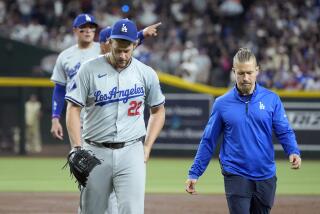Carter Hasn’t Yet Tired of Crouch Potato Life
VERO BEACH, Fla. — It is expected of a top-flight major league catcher today to throw out 40% of those on the bases attempting larceny.
The catcher is expected to start 125 games or more, and he is expected to hit.
At this stage of the going, approaching age 37, embarked on his 20th year of professional baseball, Gary Carter can still hit.
And, on the strength of that skill, sought by a club searching for right-handed power against left-handed pitching, Carter gropes for work with the Dodgers, in the market for what is called a backup.
Carter is not one of those sad cases of the old pro needing a job to look after the wife and kids. His bankroll should only happen to a lot of us.
He wants to keep pulling the string, for wages much less than he is used to, because he hasn’t yet positioned himself mentally to let go.
Gary admits readily it is a form of derangement.
“I swear to you solemnly,” he says, “I am not trying to make this team for the money. I am out there, training harder than I ever trained in my life, totally to convince myself I can still play ball.”
Over the last couple of years, the Mets have said he can’t. And the Giants have said he can’t. The Dodgers have said, “Let’s take a look.”
So, given until March 25 to make his case, Carter, an artist selected for 11 All-Star teams, including nine in a row between 1980 and ‘88, roams the grounds, running, stretching, pumping iron, fighting his own war against a nasty foe called age.
The spirits of Gary are good for one whose knee blew out in New York and whose shoulder followed suit in San Francisco.
Protecting home plate, Gary dredges up for us this index of misery:
“A player named Alberto Luis broke my thumb. Doug Frobel broke my rib. Tony Taylor wrecked ligaments in my knee. Tony Scott tore ligaments in my ankle. Gary Maddox knocked me goofy with an elbow to the temple. And I have been laid out by Dave Parker, Dave Kingman and others too numerous to recall.”
It always was, and remains, the mature judgment of Johnny Bench, who advanced to the Hall of Fame, that catchers shouldn’t try to be heroes in the tradition of the craft.
In others words, home plate should be blocked only if a critical run is at stake. Creating collisions for the purpose of establishing one’s gameness is ignorant, “especially if the catcher has a good bat and the collision will take that bat out of the lineup.”
Bench did well with that line of thought, also contending that a catcher should come out of his debilitating crouch after maybe 10 years and shift to first base.
First base is Sun City for the baseball aged, including such as Mickey Mantle, Willie Mays and Pete Rose, who never earned a living crouching.
Gary began crouching for money as early as 1972 with a team in Cocoa, Florida, giving up a genteel game called football. He had signed a letter of intent to play quarterback for UCLA.
But choosing to crouch, he joins up with baseball, gainfully employed until the spring of ‘91, when he is asked to show cause why the Dodgers should enlist him.
We ask Carter: “What is your game plan in the event the Dodgers give the job to someone else?”
Naturally, he responds that he would like to get into broadcasting, which must be a sweet touch, considering the number of retiring athletes seeking to enter that field.
“My mind is focused only on landing with the Dodgers,” says Carter. “I still have baseball in my system. There is an excitement to playing that is hard to describe. I’ve got one more shot.”
Gary’s last shot contained cortisone. It went into his knee, but, unlike an errant Scud, would have been helpful wherever it landed.
More to Read
Are you a true-blue fan?
Get our Dodgers Dugout newsletter for insights, news and much more.
You may occasionally receive promotional content from the Los Angeles Times.






